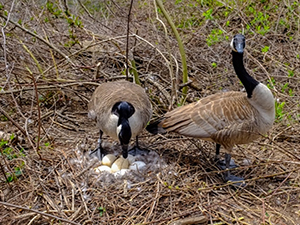How Farms Can Manage Nuisance Birds This Spring
Mar 12, 2024
For farms, spring is the time to prepare for the year’s initial planting. It’s also the time when migratory birds return north during their spring migration, and resident and/or colonial birds look to establish nesting.
From February through May, migratory birds – such as Canada geese and snow geese – as well as colonial birds – such as ring billed and herring gulls – pair and begin to establish nests.
While precise incubation periods vary by bird species, once a clutch of eggs is laid, it takes just around a month for the young to hatch. With an average egg clutch size of three to six eggs, a few, paired nuisance birds can quickly become a much bigger problem to manage.
Why Should I Evict Nuisance Birds off My Property?
Nuisance birds pose threats to properties across the agricultural supply chain, in ways both obvious and more subtle.
Wild birds eat seeds, produce and grain, which leads to crop – and revenue – loss. They also pose biosecurity risks to poultry and egg farms and threaten human health and safety in agri-processing and bioprocessing facilities. Because birds carry disease and damage property and products, it’s advisable to manage them promptly and to closely monitor your property for signs of nesting in the spring.
How Can I Tell if Nuisance Birds Are Nesting on My Property?
Nuisance bird characteristics that typically indicate nesting behavior include:
- Clear pairings of adults
- Aggressive or territorial behavior
- Evidence of nesting (e.g., materials, eggs)
Can I Harass the Nuisance Birds off My Property?
Yes – it is possible to harass nuisance birds off your property, but timing is critical. Once a pair of birds selects your property to nest on, it can be challenging to persuade them to leave. After a nest has been established, birds spend the remaining spring months defending their nests, eggs, and young. Because of this, tried and true harassment techniques are often less effective than they normally are. The reduced effectiveness is even more pronounced if your property has a history of nuisance bird nesting.
If Harassment Is Less Effective During Nesting Season, What Can I Do?
If your property has nesting nuisance birds and/or a history of nuisance bird nesting, the first step is to reduce the overall population of targeted nuisance birds through nest and egg management. This service involves multiple, routine visits from licensed technicians to the property throughout the nesting season to search for any and all nests/ eggs and adequately manage them.
All bird species except for a few – such as pigeons, starlings, and sparrows – are protected under the federal Migratory Bird Treaty Act. As such, permits are required from state and/or federal regulators before your property can manage nesting nuisance birds or their nests/ eggs. To remain compliant, the data collected during these nest and egg management visits must be managed in the prescribed format and reported to the relevant regulators by set deadlines.
When Does Nuisance Bird Harassment Succeed?
Harassment techniques for migratory and/or resident nuisance bird populations are most effective once nesting is managed. Harassment programs are recommended to occur during peak migration seasons: spring, which is typically February to May; and fall, which is typically September to November.
Lasers are a viable nuisance bird harassment technique for farms, agri-processing, and bioprocessing facilities, due to their size and characteristics. Depending on your property’s unique needs – and the species and nature of the threat posed by birds – one of two options may be most appropriate:
Automated Lasers
Automated lasers can provide continuous harassment of nuisance birds. They have a range of over a mile and can cover multiple acres. Because each automated laser is customized based upon specific bird species and site characteristics, birds do not habituate.
Handheld Lasers
Handheld lasers can provide ad hoc harassment of nuisance birds. The laser beam can travel over a mile, and, because of the laser’s portable nature, it can cover a large surface area in a short amount of time.
Keep Your Property Free from Migrating Nuisance Birds this Spring
Whether you grow soft fruit, manage a poultry farm, or process grain, nuisance birds can upend operations on your property. With spring migration upon us, now is the time to vigilantly monitor for signs of nesting birds – and act quickly if they are spotted.
Wild Goose Chase Indy’s staff biologists and trained, licensed technicians work at the intersection of animal, environmental and construction science to effectively manage avian wildlife on properties across the agricultural industry. The solutions we implement are holistic and guided by deep expertise – and result in lasting bird control.
Contact us to schedule a site evaluation or to learn more about the services we provide.
Contact us to learn about bird control for the agricultural industry


 0
0
